Physical Address
304 North Cardinal St.
Dorchester Center, MA 02124
The principle of Z-plasty is one of the most versatile concepts in reconstructive surgery. The dynamics of tissue movement that occur with Z-plasty are particularly suited for certain types of scar revision. A clear understanding of the underlying principles of Z-plasty will allow the reconstructive surgeon to apply this technique to a wide array of clinical situations.
The history of Z-plasty has been reviewed by Borges and Davis and Renner. Classically, this technique involves designing a Z with three limbs of equal length that form two triangular flaps of equal angles. The triangles represent angular flaps that are interchanged with each other by both pivotal and advancement tissue movement. Although the initial description of transposing equilateral triangular flaps was written by Berger in 1904, numerous other descriptions have been recorded. In the 1800s, Fricke, Horner, Serre, and Denonvilliers described the transposition of cheek and temporal skin to correct eyelid ectropion and regional defects. In these case descriptions, however, the triangular flaps transposed did not have equal angles, nor were they the same size. In the late 1920s, Limberg elucidated the geometric principles involved with Z-plasty. He also noted that Z-plasties, as well as the related Limberg or rhombic flap, are best described as having both pivotal and advancement components. Whereas the classic Z-plasty follows specific geometric guidelines, Limberg demonstrated the flexibility of double transposition flaps that have a Z-plasty design. It is this flexibility that allows the wide-ranging applications and variations from the classic description.
A Z-plasty is used to accomplish one or more of three changes in the nature of a scar: change of scar direction, interruption of scar linearity, or release of scar contracture (lengthening of the scar). Z-plasty should be considered when it is optimal to change the direction of a scar so that a portion of it is more easily concealed either within relaxed skin tension lines (RSTLs) or in a border between facial aesthetic regions. Similarly, with Z-plasty, a long straight scar may be divided into smaller irregular segments to allow for better scar camouflage. Scars that cause distortion of facial features secondary to contracture may be lengthened with Z-plasty techniques to correct or improve the distortion. As with other methods of scar revision that interrupt a straight scar, the scar resulting from Z-plasty will counter forces of scar contracture. This is because of the very nature of the Z-shaped scar that occurs from Z-plasty. Each segment of the Z contracts in a different direction. Z-plasty is particularly useful in treating contracted or webbed scars and scars that distort anatomic facial landmarks. A main advantage of Z-plasty over other techniques, such as W-plasty, is that it does not require skin excision for the procedure to be performed.
Mastery of the principles of Z-plasty allows its implementation in a number of situations. Correction of scars that cross the melolabial crease represents an ideal application of Z-plasty. In this circumstance, the central limb of the Z-plasty, which consists of the original scar, is moved into the crease. Wide or confluent scars treated with excision and primary closure often lead to significant wound closure tension. Z-plasty used along the wound margins to create an irregular scar has the effect of dispersing wound tension. Short (less than 2 cm) scars that do not rest in RSTLs are often best managed by Z-plasty. Contracted or webbed scars located in concavities are amenable to correction by Z-plasty. This includes vertical scars located in the concave areas of the neck, radial contractures that traverse the concavities of the auricle, and scar bands that cross the concave medial canthal region. Ectropions and retractions of the lower eyelid caused by vertically oriented scar contracture are often best corrected with Z-plasty because of its ability to release scar contracture. Similarly, lip scars are often contracted and require Z-plasty to lengthen the scarred segment and to restore a normal contour to the vermilion border. This listing of indications for use of Z-plasty is far from inclusive. For optimal results, many situations require a combination of scar revision techniques, such as W-plasty or geometric broken-line closure, in addition to Z-plasty.
The classic description of Z-plasty consists of a design in which the central limb and two peripheral limbs are in the shape of a Z such that two triangle-shaped flaps of equal size are created. All three limbs are of identical length, and the central limb consists of the scar that is to be lengthened or realigned. In the standard 60° Z-plasty ( Fig. 14.1 ), a protractor may be used to measure the angles. Nevertheless, a more practical means of estimating Z-plasty angles is to mark out a 90° angle and to divide it into thirds. A caliper or ruler is useful in the design of limbs of equal lengths. Transposition of the triangular flaps (angles ABC and BCD in Fig. 14.1 ) results in the following changes: the axis of the central limb is rotated 90° (in the example, a vertical scar is changed to a horizontal orientation); the distance between the points labeled B and C of the original central limb is increased; and the final scar is changed from a straight line to a nonlinear Z configuration. The overall length of the new scar created by the Z-plasty is increased by the sum of the length of the peripheral limbs of the Z.
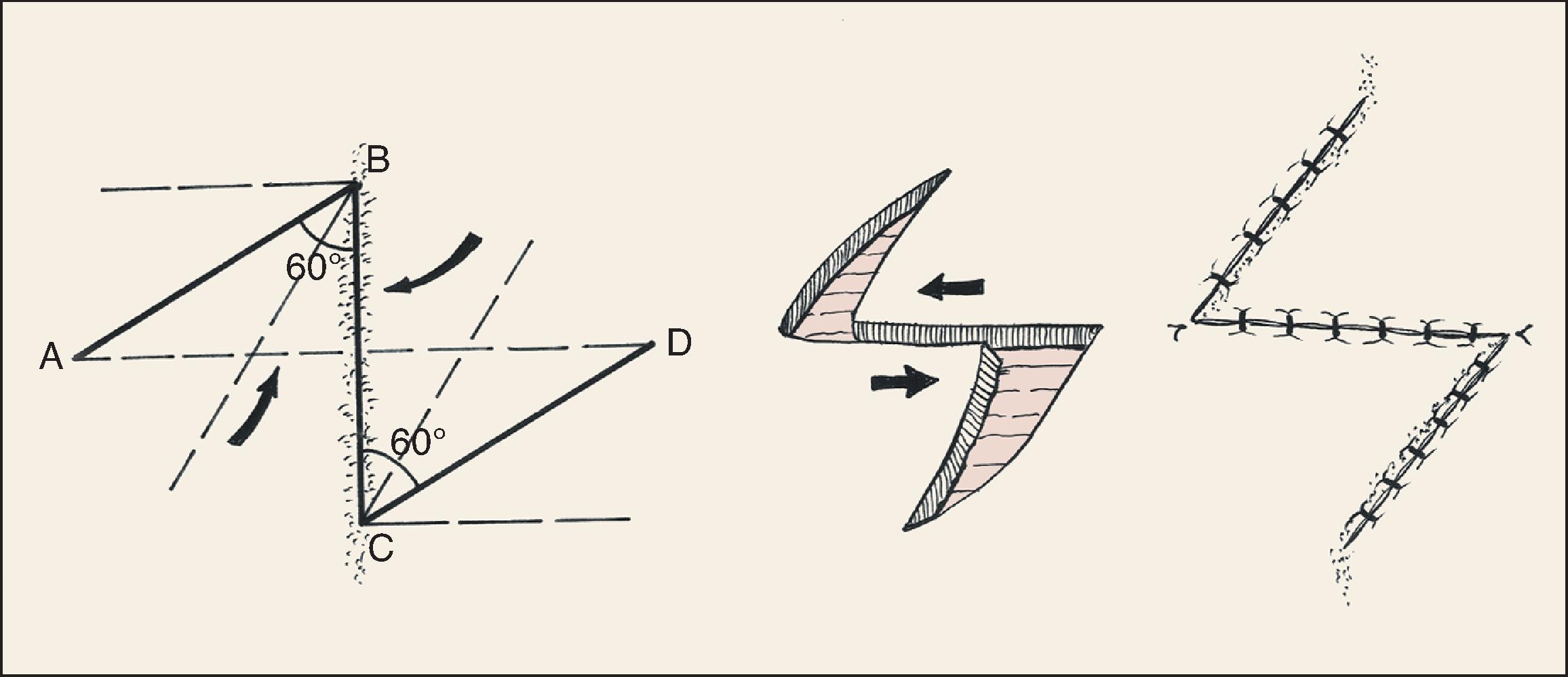
Although a 60° Z-plasty is perhaps the most common design, angles between 30° and 90° are possible. Changing the angle of the flaps will cause a change in the length gained in the axis of the original central limb ( B-C in Fig. 14.1 ). Theoretically, the percentage gain in length increases with larger angles ( Fig. 14.2 and Table 14.1 ). In practice, however, the amount of lengthening noted is usually less.
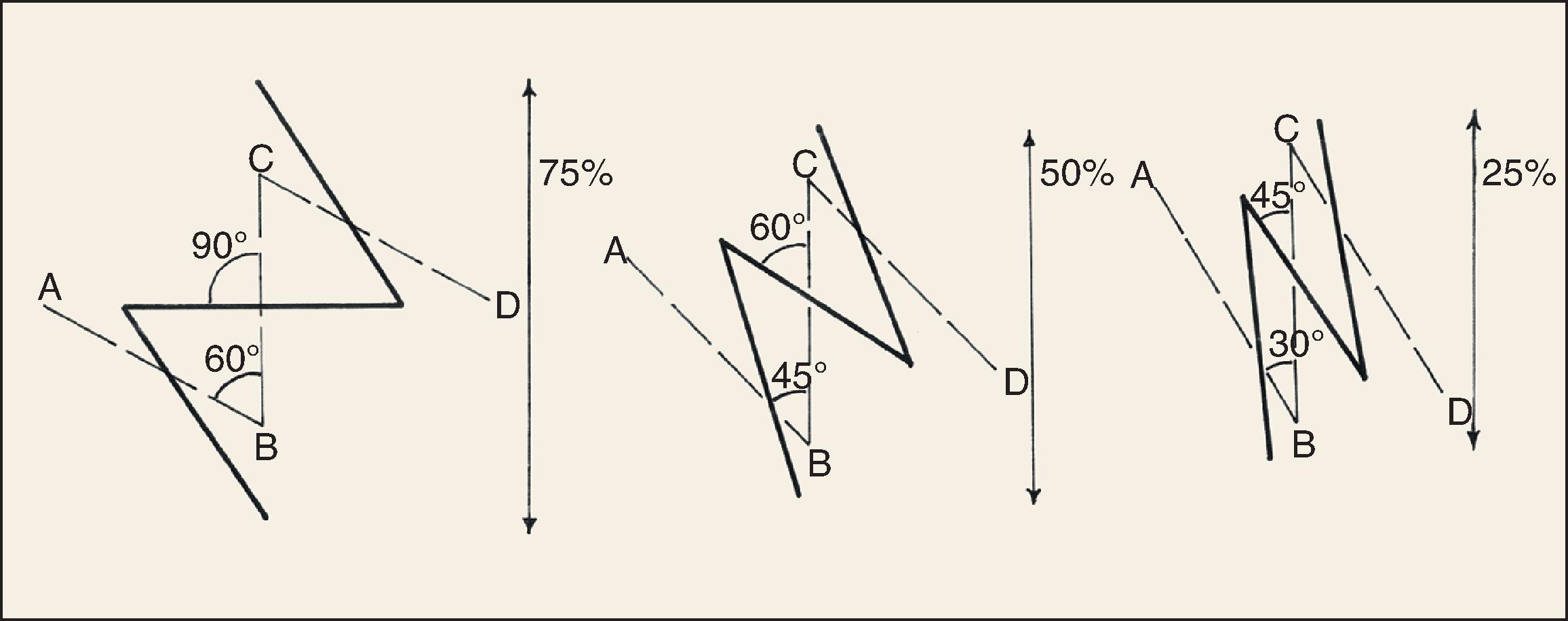
| Z-Plasty Angles | Gain in Length (%) |
|---|---|
| 30°–30° | 25 |
| 45°–45° | 50 |
| 60°–60° | 75 |
| 75°–75° | 100 |
| 90°–90° | 125 |
The degree of directional change of the central limb of the Z-plasty ( B-C in Fig. 14.2 ) is also variable. In the 60° Z-plasty, the orientation of the central limb is changed 90° from its original orientation. In the 45° Z-plasty, the orientation of the central limb is changed approximately 60° from its original position. In the 30° Z-plasty, the change is approximately 45° (see Fig. 14.2 ). This relationship between the angle of the Z-plasty and the change in orientation of the central limb of the Z-plasty is an extremely important consideration in planning of Z-plasty ( Table 14.2 ).
| Variance to RSTLs | Z-Plasty Design |
|---|---|
| 90° | 60° Z |
| 60°–90° | 60° Z (try to follow RSTLs as much as possible) |
| 30°–60° | Parallel to RSTLs |
| 30° | Fusiform excision best |
The initial length of the central limb affects the final outcome of Z-plasty. As the central limb of the Z is increased in length, so too is the gain in linear length between the points marking the ends of the central limb (points B and C in Fig. 14.1 ). Unfortunately, as the three limbs of the Z-plasty become longer, there is also a greater likelihood of a more apparent scar ( Fig. 14.3 ). Multiple Z-plasties with shorter limbs to replace a single large Z-plasty with long limbs can circumvent this problem ( Fig. 14.4 ). In this instance a single long scar is divided into several smaller Z-plasties, usually with 60° angles. A single large 60° Z-plasty provides more gain in length than multiple small 60° Z-plasties along the same central limb. Nevertheless, the aesthetic consequences and tissue availability for construction of the Z-plasty flaps often preclude the use of a single, large Z-plasty. On the face, limb length is usually limited to 1 cm or less. On the neck, limb length should not exceed 2 cm.
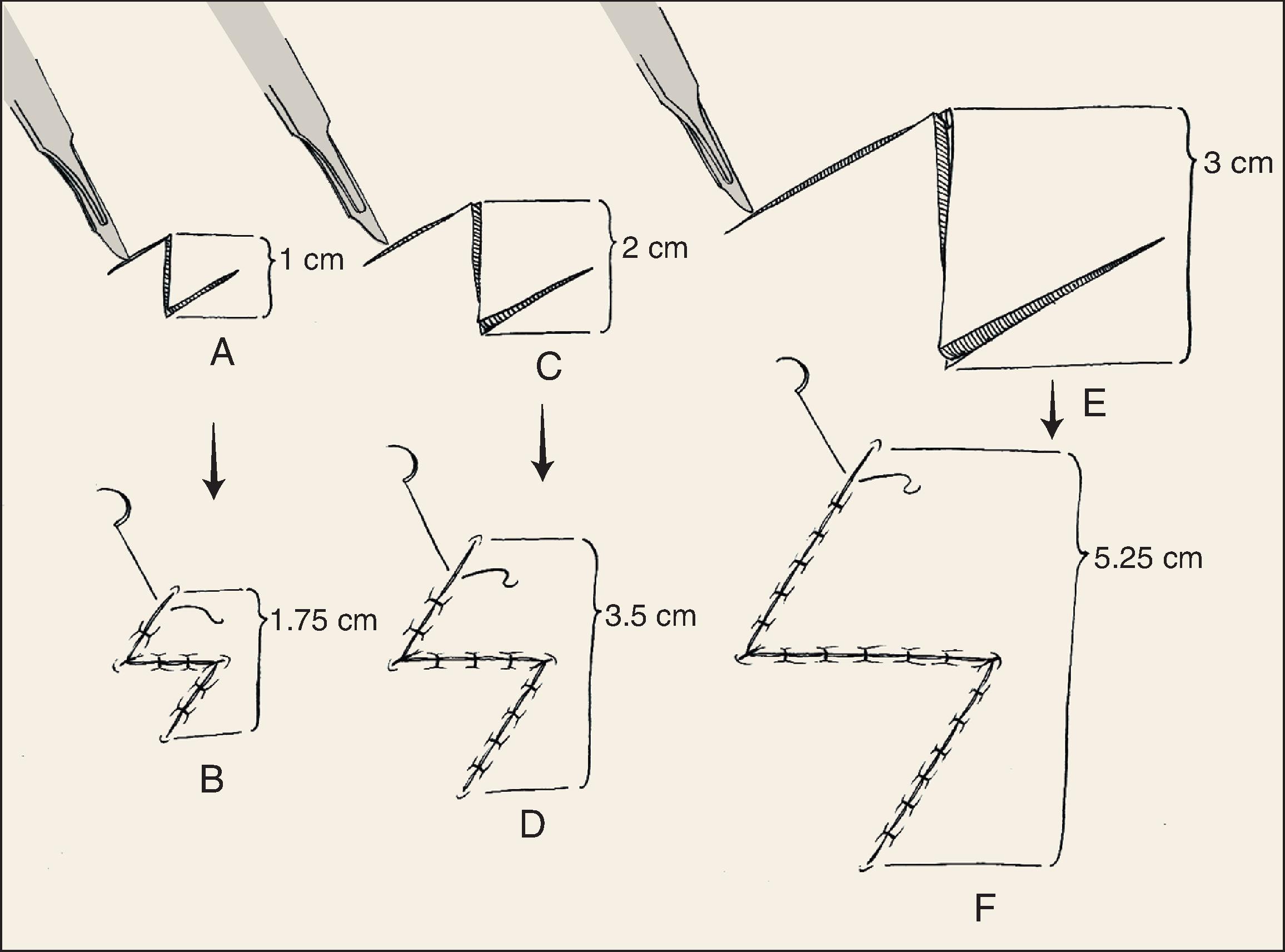
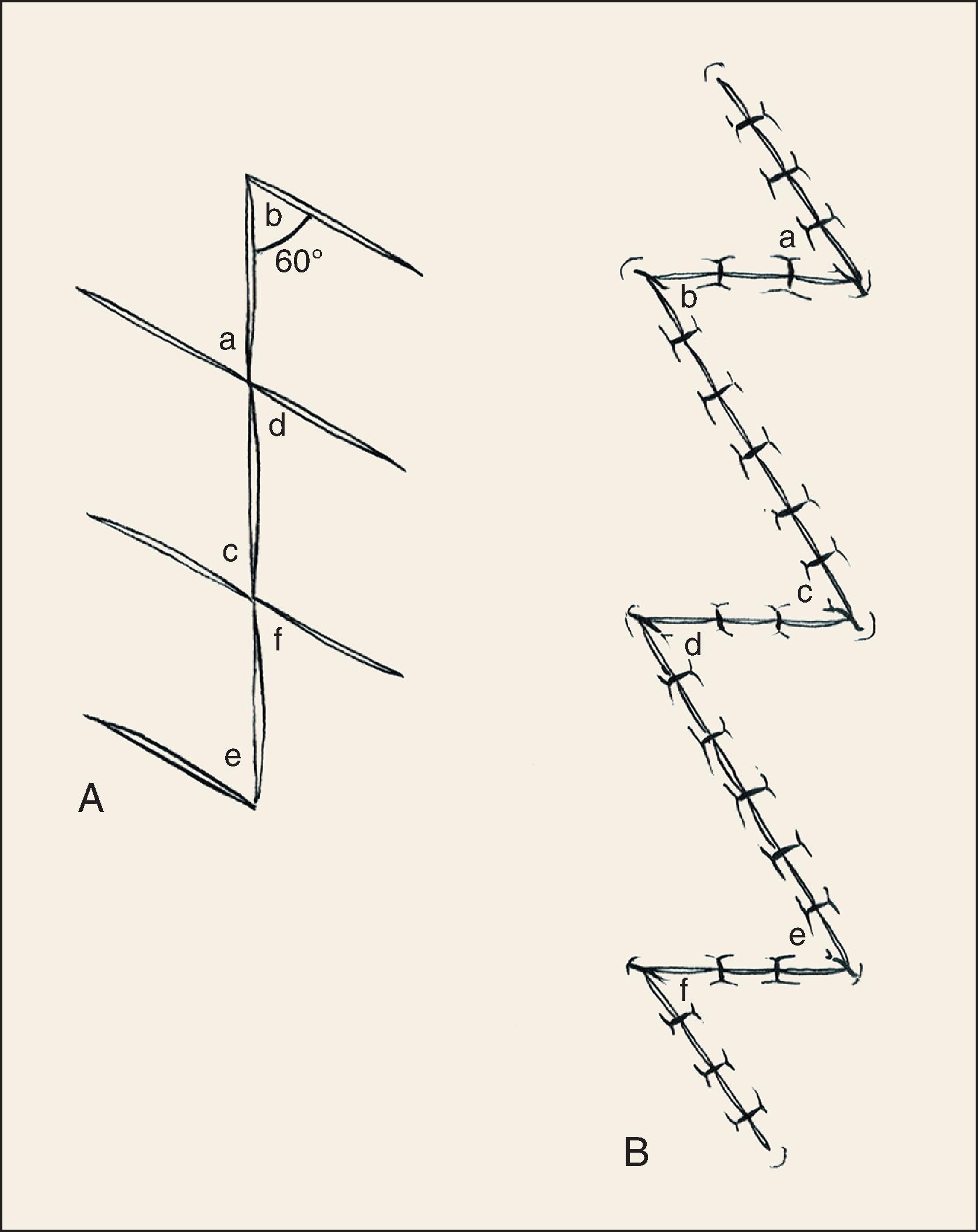
In addition to the ability to vary limb length and angles of a Z-plasty, the actual design of a Z-plasty can be modified. One example is the four-flap Z-plasty. This technique increases the gain in length of the central limb by using four triangular flaps that are interposed between each other. A 90° Z-plasty is first designed, and then the 90° angle is bisected to design two 45° triangular flaps that are transposed ( Fig. 14.5 ). Even greater gain in length of the central limb of a Z-plasty can be obtained by using 120° angles, which subsequently are bisected into four 60° flaps ( Fig. 14.6 ). There are a number of variations on this theme, including a six-flap Z-plasty. The greater the number of flaps created, however, the greater the total number of limbs and thus scars and the greater the number of standing cutaneous deformities (SCDs) that develop when the flaps are transposed. Z-plasty may also be modified by use of flaps that have unequal angles. In such situations, the flap with the more acute angle is pivoted in a greater arc than that of the larger angled flap ( Fig. 14.7 ). Minimal gain in length of the central limb will occur with unequal-angled Z-plasties. The main purpose of such designs is to transpose skin of the smaller angled flap to a more desirable location.
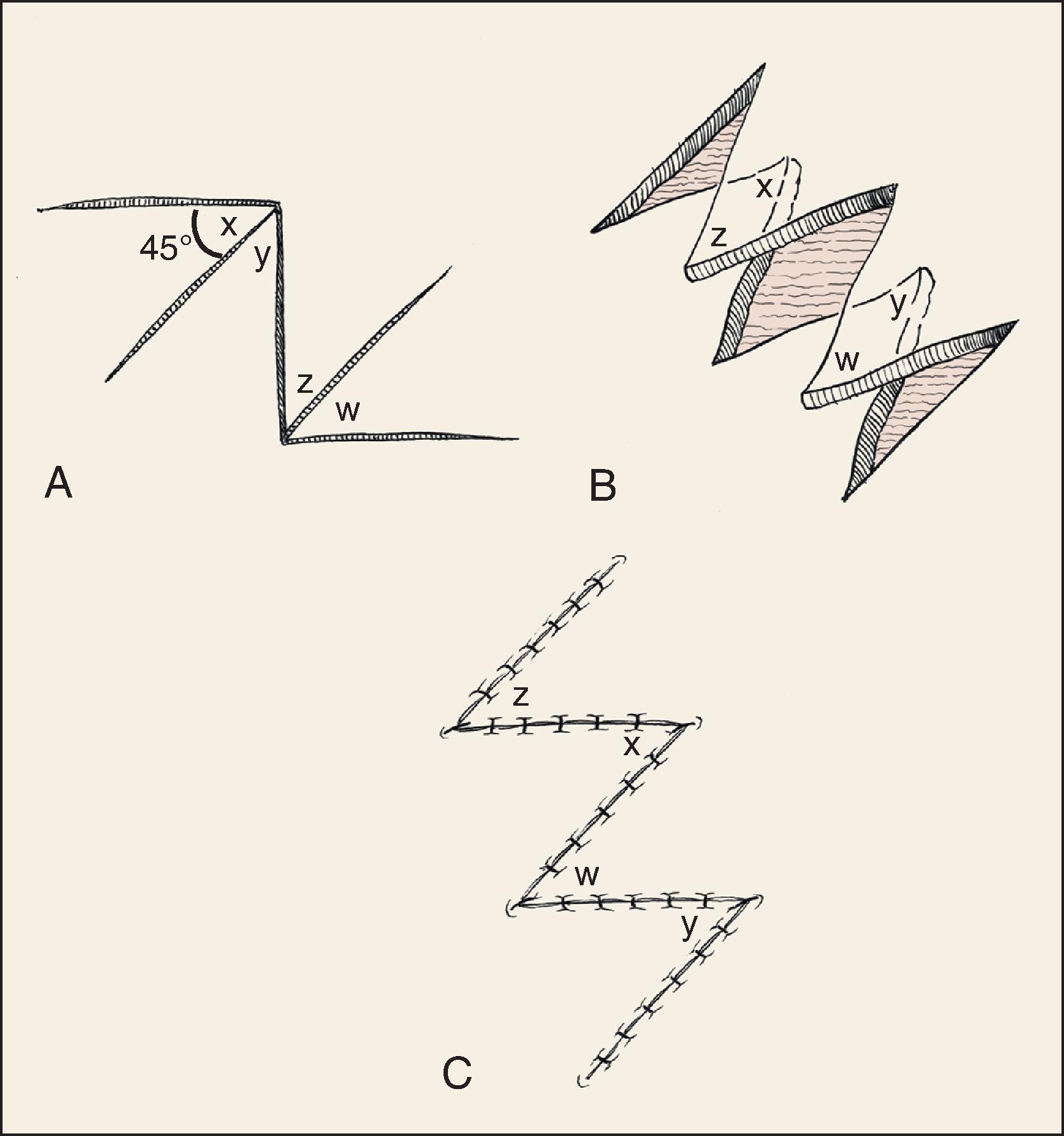
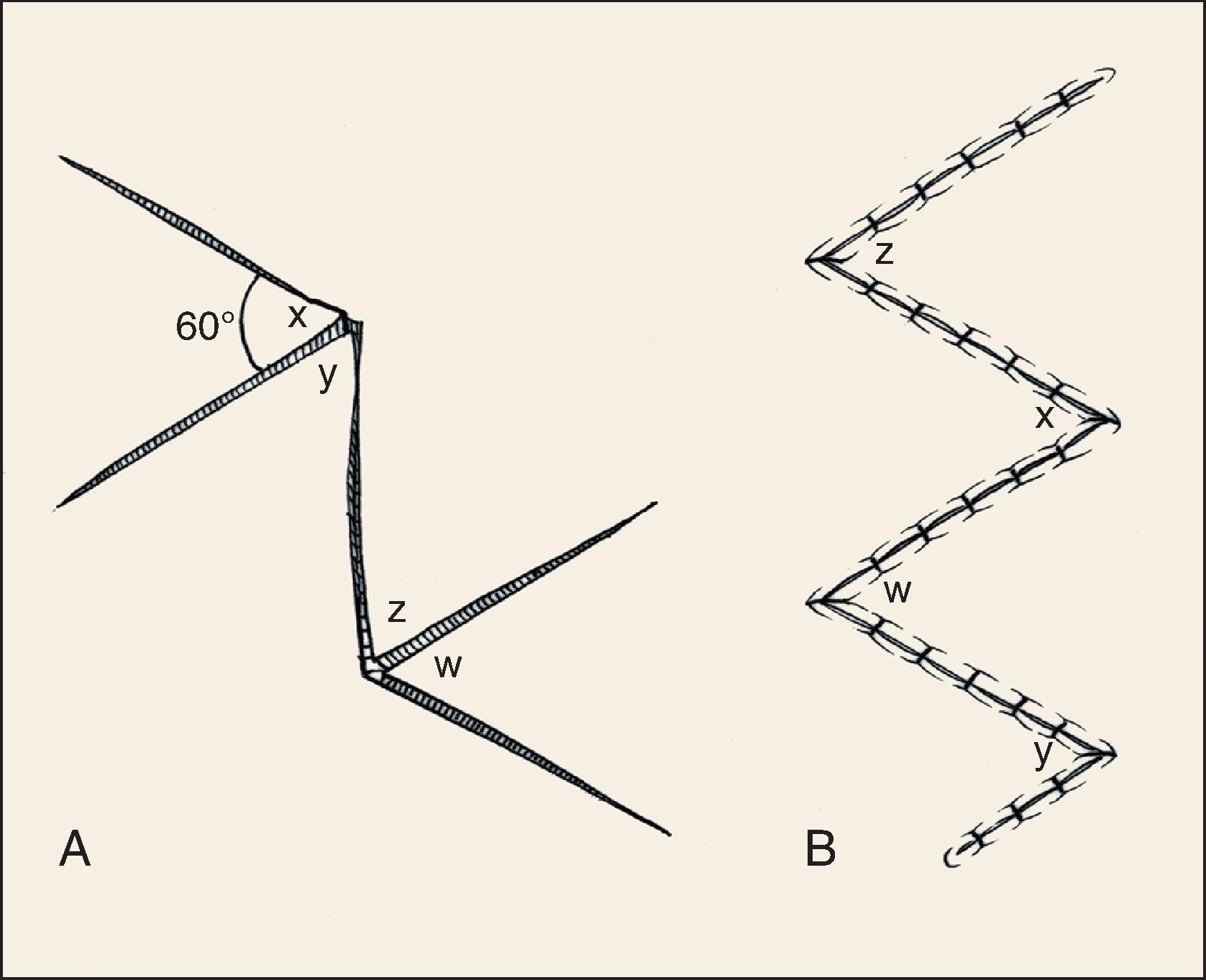
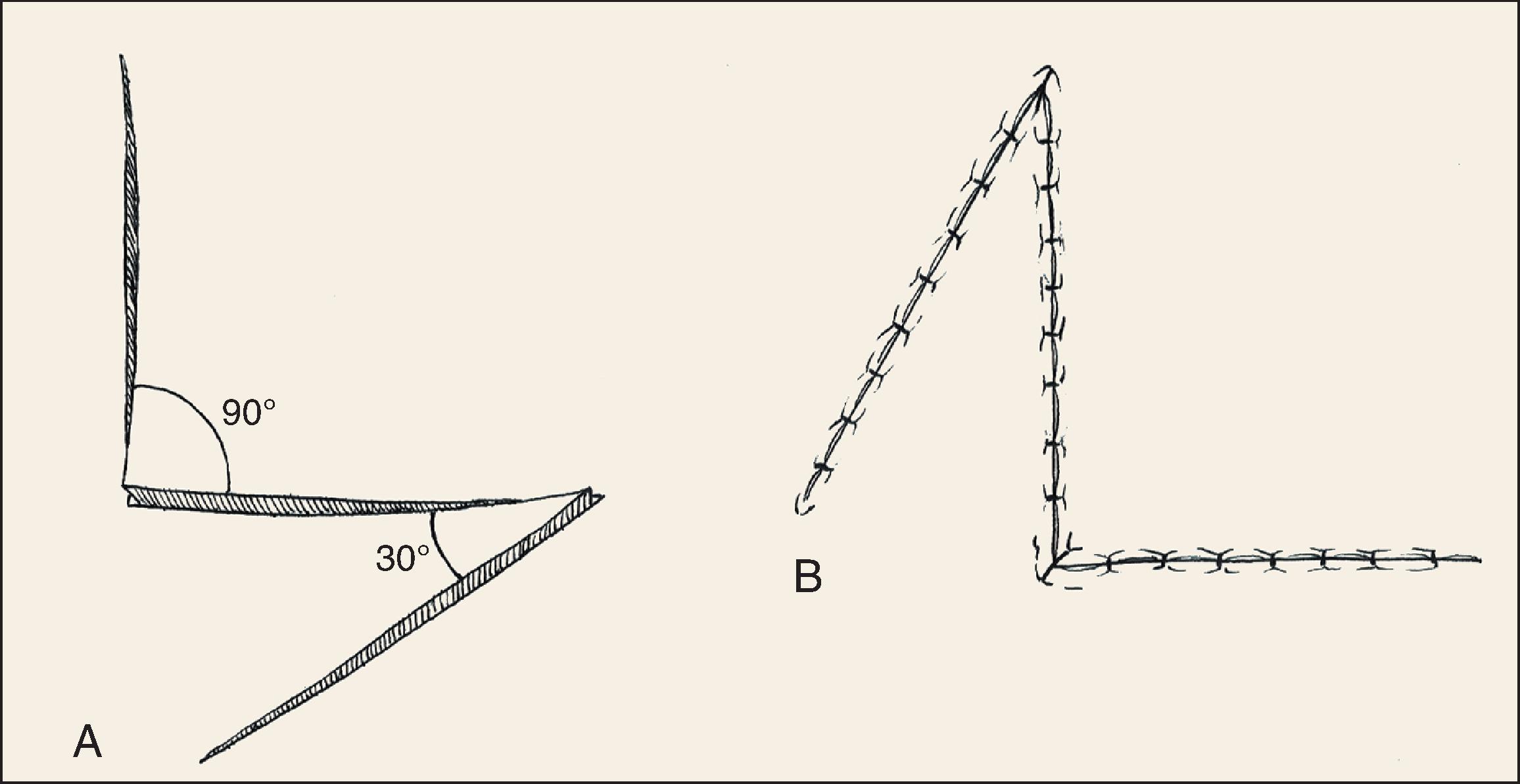
The discussion to this point has involved theoretical concerns about the classic geometry of Z-plasty. An understanding of the classic design is critical, but practical clinical considerations are even more important. Although length in the direction of the central limb is gained when a Z-plasty is used, it is usually not increased to the degree calculated. A number of studies have shown that the increase is considerably less in the clinical situation compared with the calculated gain. Similarly, there is a limit to the angles of the Z-plasty flaps that may be useful. Z-plasties less than 30° generally should not be used because of concern for vascularity of the narrow triangular flaps created by these acute angles. In the design of acutely angulated flaps, the width of the flap may be broadened by curving the limbs of the flap ( Fig. 14.8 ). This modification may be useful in skin with an impaired blood supply, such as scar contracture associated with a burn or previous irradiation. Conversely, triangular flaps with angles greater than 75° will commonly produce SCDs that require excision. Thus such large angled Z-plasties should be avoided whenever possible.
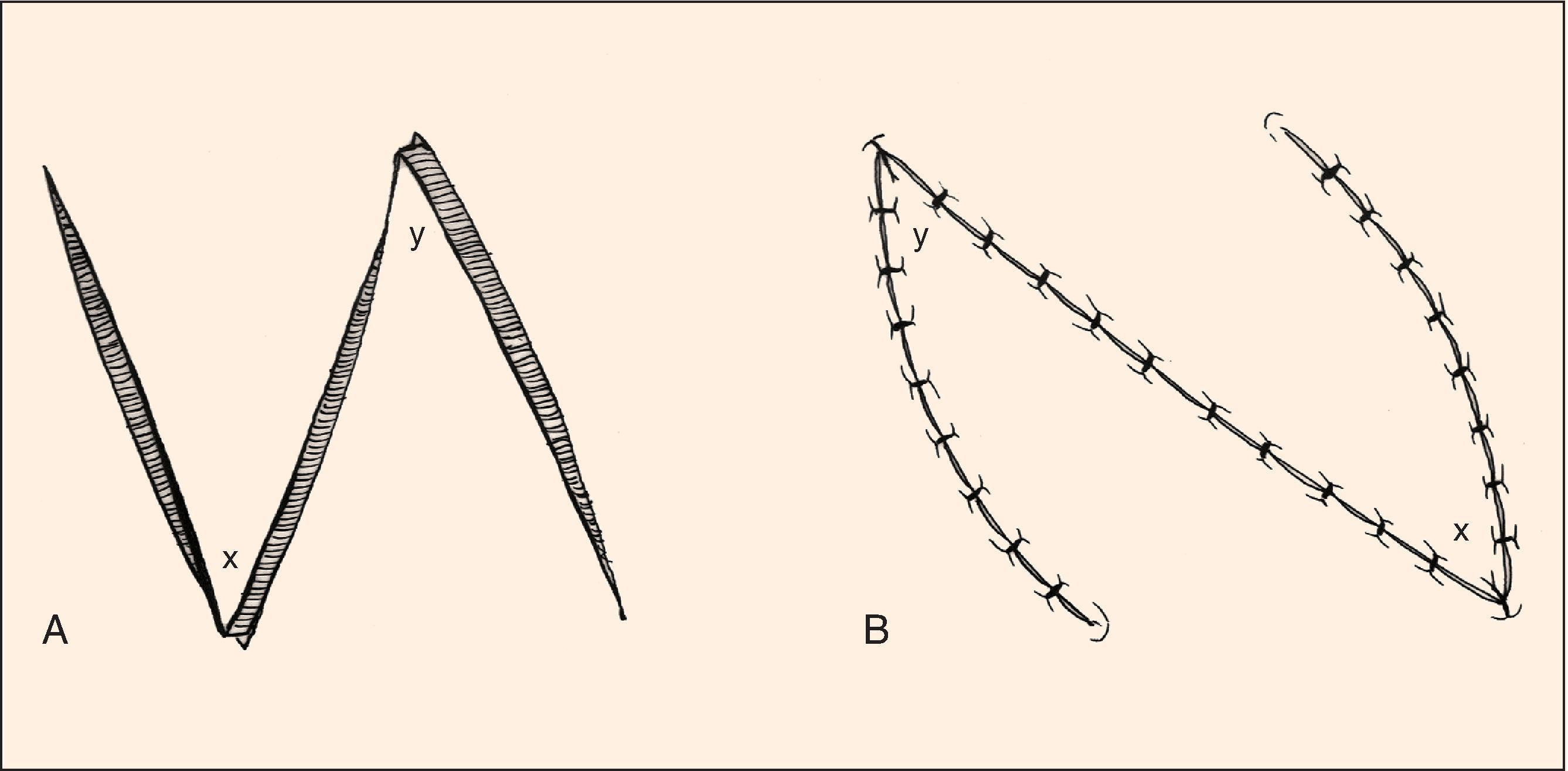
In designing a Z-plasty, evaluation of the surrounding skin and facial structures is necessary. Skin laxity at the base of each triangular flap of the Z-plasty must be adequate to allow proper pivotal movement of the flaps. If skin is contracted in a direction perpendicular to the central limb, Z-plasty may not be possible. Likewise, if a facial structure such as the eyelid, oral commissure, lip, or nasal ala is in proximity of the Z-plasty, distortion of these structures may occur. In planning the Z-plasty, it is also important to assess the degree of scar tissue in the central limb of the Z. The scar must be adequately resected or released to reduce resistance to transposition of the Z-plasty flaps ( Fig. 14.9 ). Accordingly, it is essential to release and commonly to remove subcutaneous scar tissue.
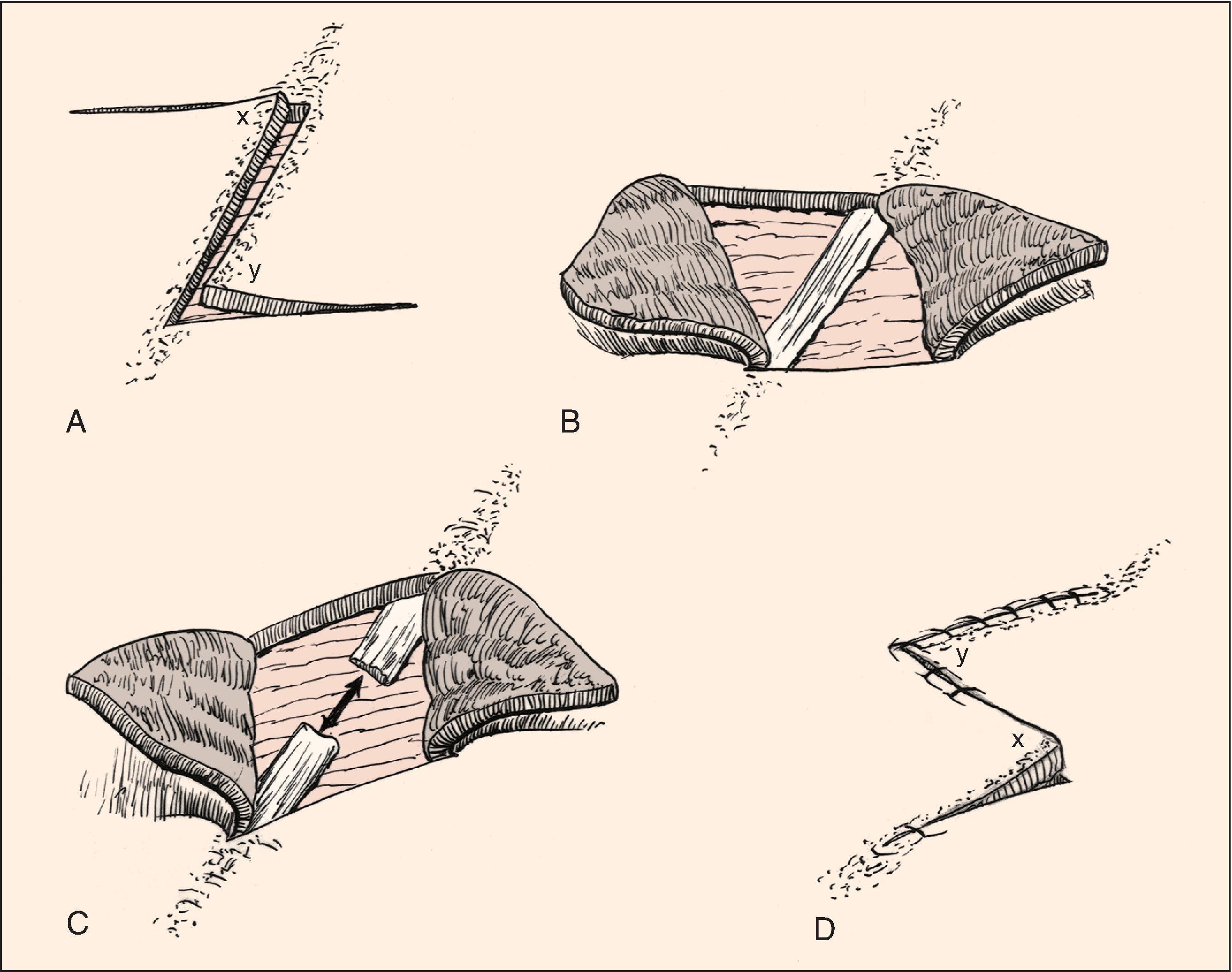
A 60° Z-plasty will reposition the central limb 90°; more acutely angled Z-plasties will position the central limb less than this. An understanding of this concept will assist in proper positioning of Z-plasty limbs in relation to RSTLs. To reposition the central limb of a Z-plasty in RSTLs, the angles of the Z should be calculated accordingly. With scars located approximately 90° to RSTLs, a 60° Z-plasty is required to reposition the central limb parallel to RSTLs. As the axis of a scar in relation to RSTLs becomes more acute, Z-plasty angles should become more acute to position the central limb and the two peripheral limb scars as parallel as possible to RSTLs (see Table 14.2 ). For scars less than 30° to RSTLs, Z-plasty may not be necessary for scar realignment. For every scar, there are always two choices for alignment of the peripheral limbs of the Z-plasty used to revise the scar. These are mirror images of one another. Both options should be considered. For scar camouflage, the selection of one of the alternatives is usually a better choice than the other because of the orientation of the resulting scar ( Fig. 14.10 ).
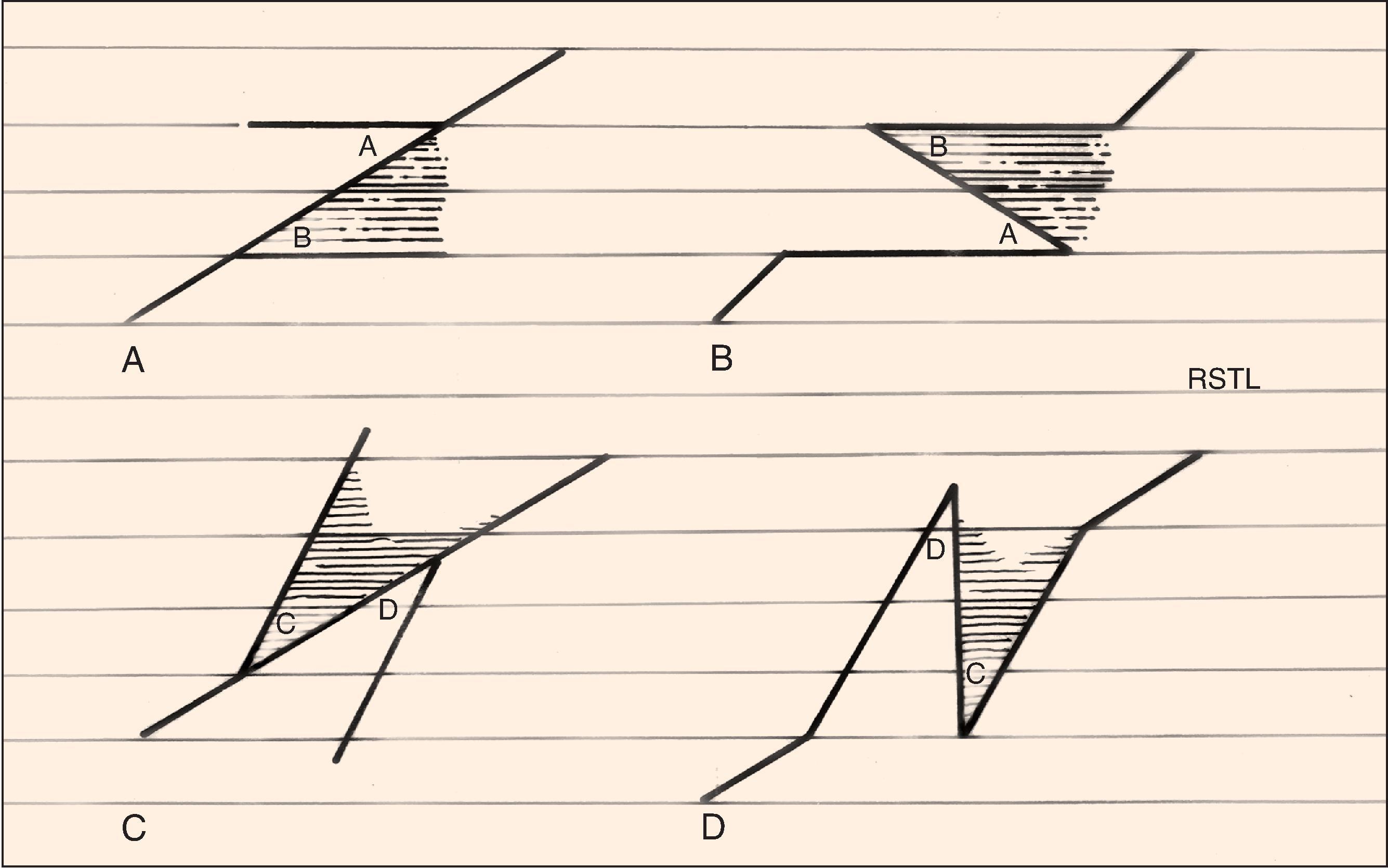
An example of a wide scar oriented perpendicular to the melolabial crease can be used to illustrate the surgical technique of Z-plasty ( Fig. 14.11 ). Improvement in the appearance is achieved by realigning the scar by a Z-plasty to translocate the scar (central limb of the Z) into RSTLs, in this case the melolabial crease. Because the scar is aligned 90° to the crease, a 60° Z-plasty is the preferred design. This will change the axis of the central limb of the scar 90° to its original axis. Note that two options exist for the 60° Z-plasty design (see Fig. 14.11 ). Fig. 14.11A illustrates the preferred design option. After transposition of the flaps, the central limb lies within the melolabial crease, and the two peripheral limbs approximate RSTLs of the lateral upper lip and medial cheek (see Fig. 14.11, C ). Conversely, even though the mirror image Z-plasty ( Fig. 14.11, D ) also realigns the central limb appropriately, the peripheral limbs of the Z-plasty have an undesirable orientation to RSTLs. Accordingly, the first option is optimal. Fig. 14.12 shows the use of Z-plasty to align a scar with the melolabial crease. Because of the length of the scar, two Z-plasties were used to accomplish the reorientation of the scar. Whereas the overall scar length has been increased by the length of four peripheral limbs, the original scar (central limb of the Z) is transposed directly into the melolabial crease for maximal scar camouflage.
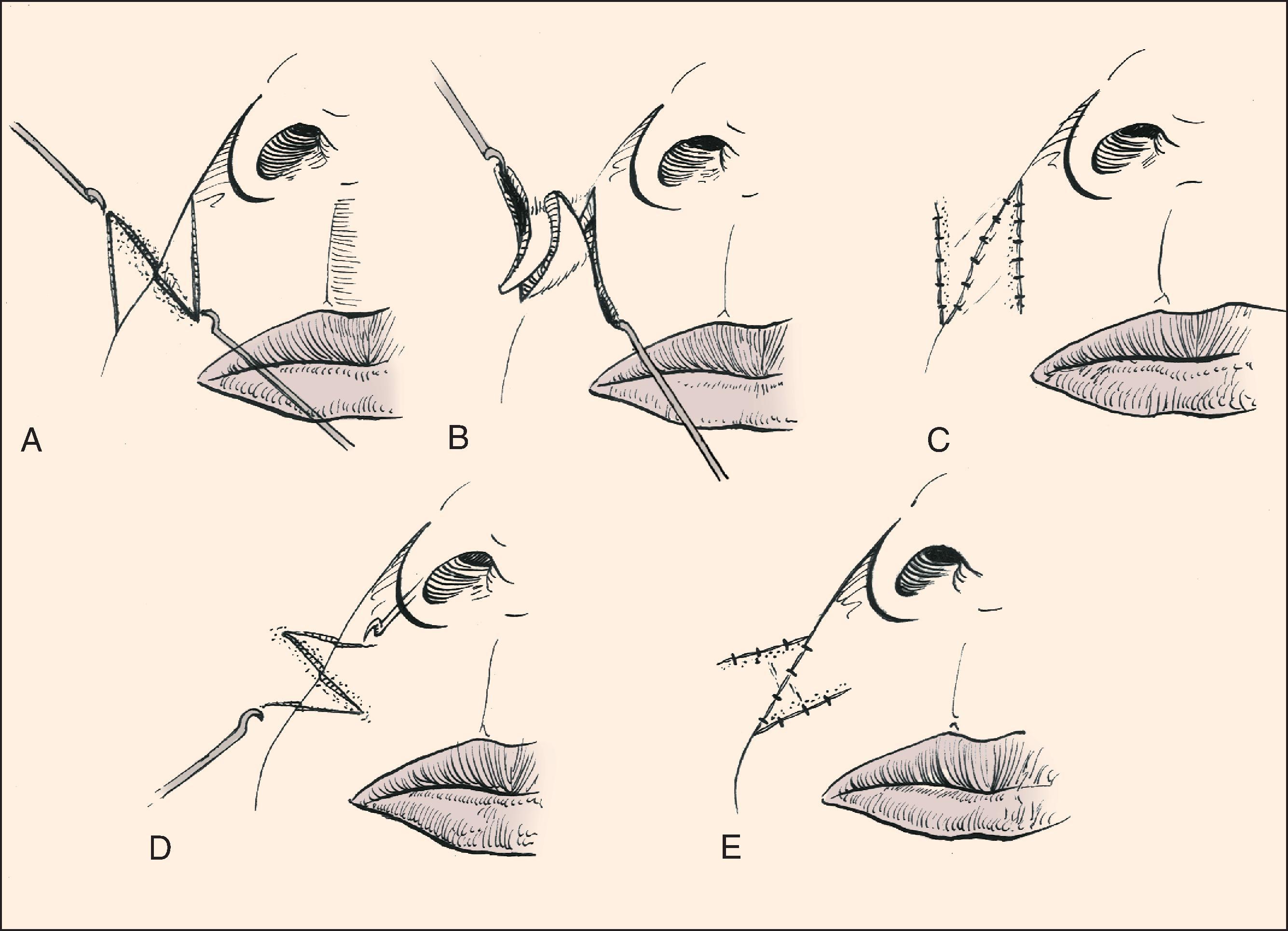
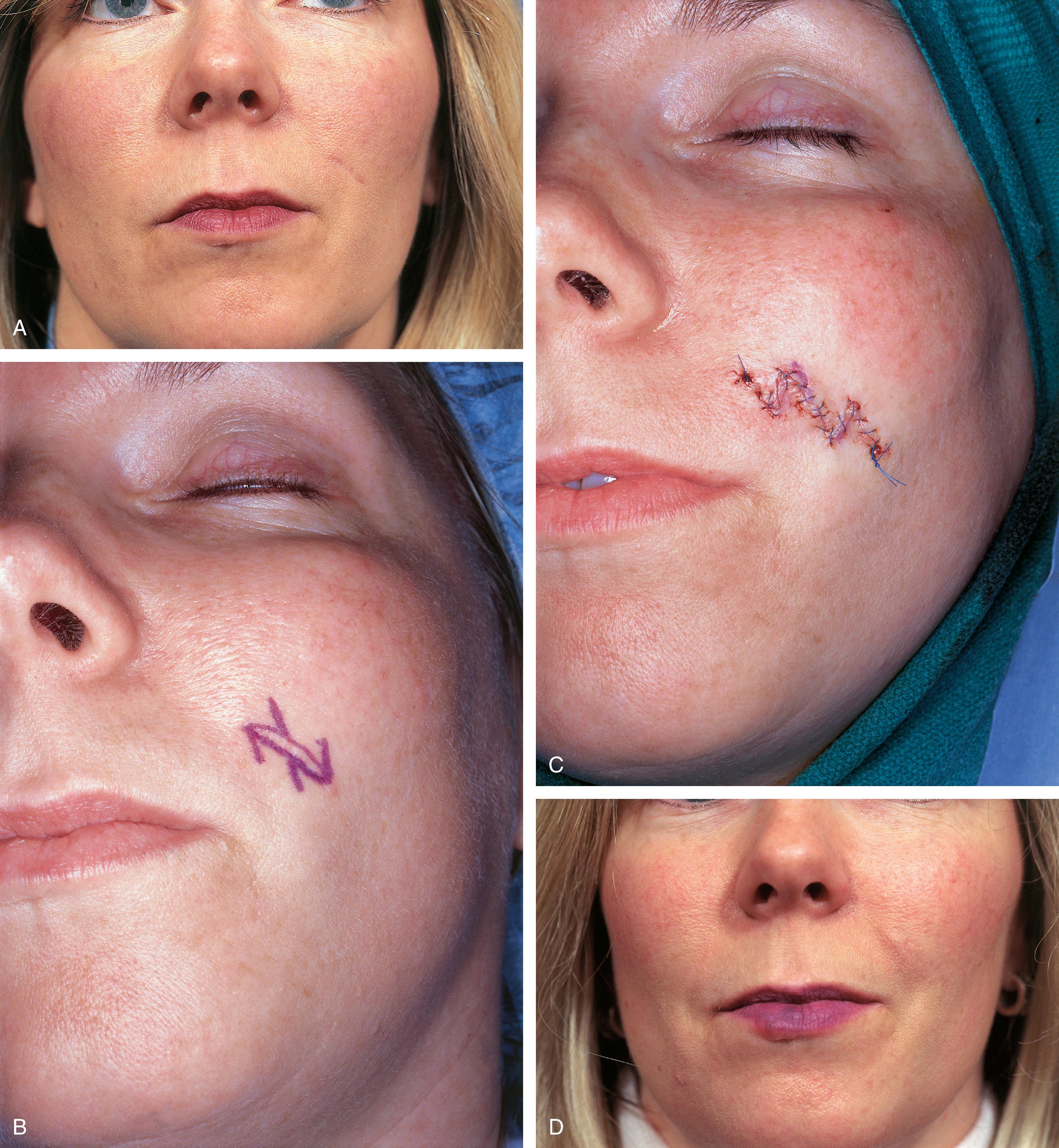
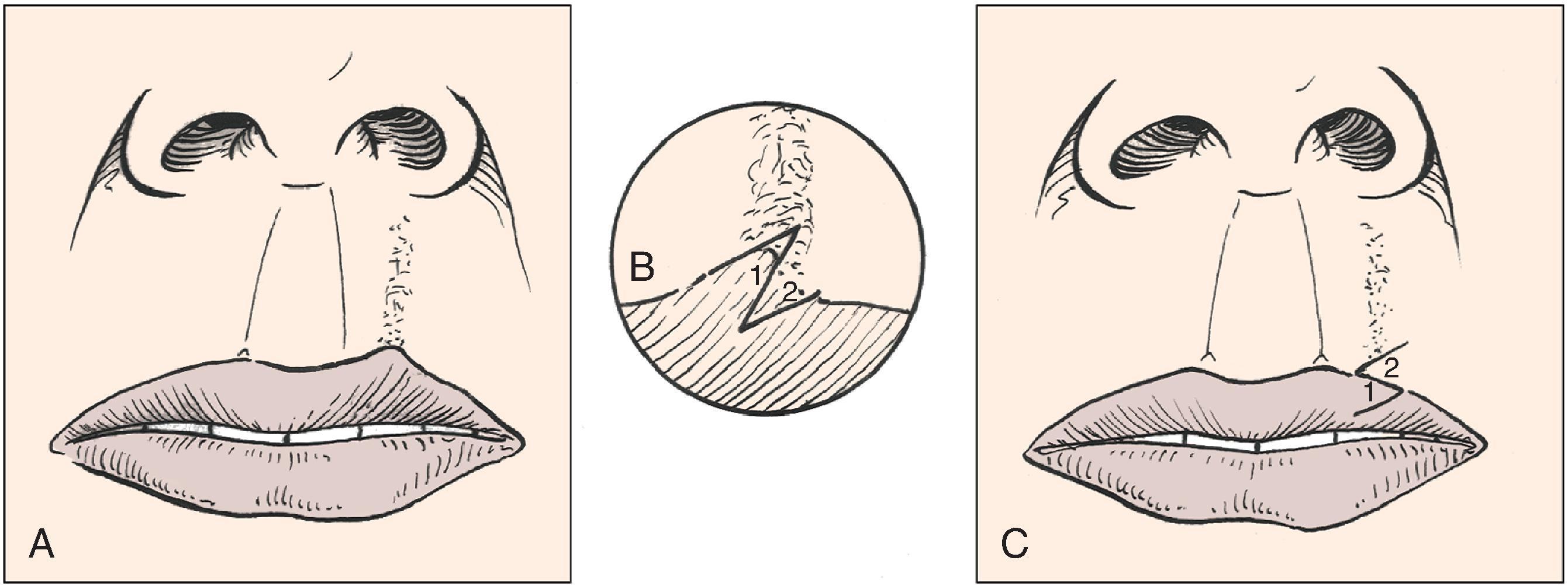
To perform a Z-plasty, the design is marked on the skin before injection of local anesthetic to avoid distortion of the skin. Proper limb length is precisely measured with a ruler or caliper. A sterile solution is used to prepare the skin, followed by injection of a local anesthetic. Significant undermining of the skin surrounding the flaps may be necessary to allow transposition of the flaps without distortion of facial structures, such as the lip, commissure, and alar base. Therefore local anesthetic is injected to the extent of the anticipated undermining. After a 7- to 10-minute pause to ensure the maximal vasoconstrictive effect of the epinephrine contained in the anesthetic, the scar is excised. In cases in which the scar is wide, it is occasionally useful to temporarily suture the wound together to facilitate the design of the peripheral limbs of the Z-plasty. Incision of the peripheral limbs follows and is best accomplished with skin fixation and incision from the base of the triangular flap toward the apex. Because of skin retraction after release of the central limb scar, there is a tendency to incise the tips of the Z-plasty flaps such that they become overly narrowed. This tendency can be countered by slightly rounding and widening the incision where the peripheral limb joins the central limb of the Z-plasty. Conversely, the peripheral limbs may be incised before the central limb is. The flaps are dissected beginning at their tips. The tips are delicately retracted with a skin hook, and meticulous sharp dissection is performed in a tissue plane just within the subdermal fat. Dissection continues well beyond the flap bases. After appropriate undermining, the flaps are easily transposed by retraction of the ends of the central limb with skin hooks (see Fig. 14.11, B ). On occasion, tension prohibits adequate transposition and necessitates further undermining and extension of the incision at the base of one or both of the flaps. The flaps are sutured in place beginning with placement of several subcutaneous sutures made of an absorbable material. The number of sutures, however, should be limited so as not to compromise the vascularity of the flaps. Skin incisions are closed with fine (5-0 or 6-0) suture material by meticulous, atraumatic, wound-everting techniques. Cutaneous sutures are removed 3 to 5 days postoperatively.
Lengthening of a contracted scar is often necessary, particularly if the scar is causing distortion of a facial structure and impairing function. An example of this is illustrated in Fig. 14.13 . In the illustration, the vermilion border is distorted by scar tissue. Such a condition may occur from a deep laceration of the upper lip or after cleft lip repair. Because additional length is required in the direction of the axis of the scar, a Z-plasty is designed with the central limb oriented along the axis of the scar. Transposition of the Z-plasty flaps results in an increased lip length in the scarred region and realignment of the vermilion border.
Similar to scars that restrict movement of the lip, long scars on the neck can impair the freedom of movement of the head ( Fig. 14.14 ). A long, webbed scar on the neck is ideal for treatment with single or multiple Z-plasties. Z-plasty not only lengthens scars and corrects webbing but may also position scars in a better relationship to obliquely oriented RSTLs. Although a single large Z-plasty may provide maximum lengthening of a neck scar, the resulting scar will tend to be noticeable because of the long peripheral limbs of the Z. Accordingly, multiple Z-plasties are preferred in most circumstances (see Fig. 14.14, C, D ).
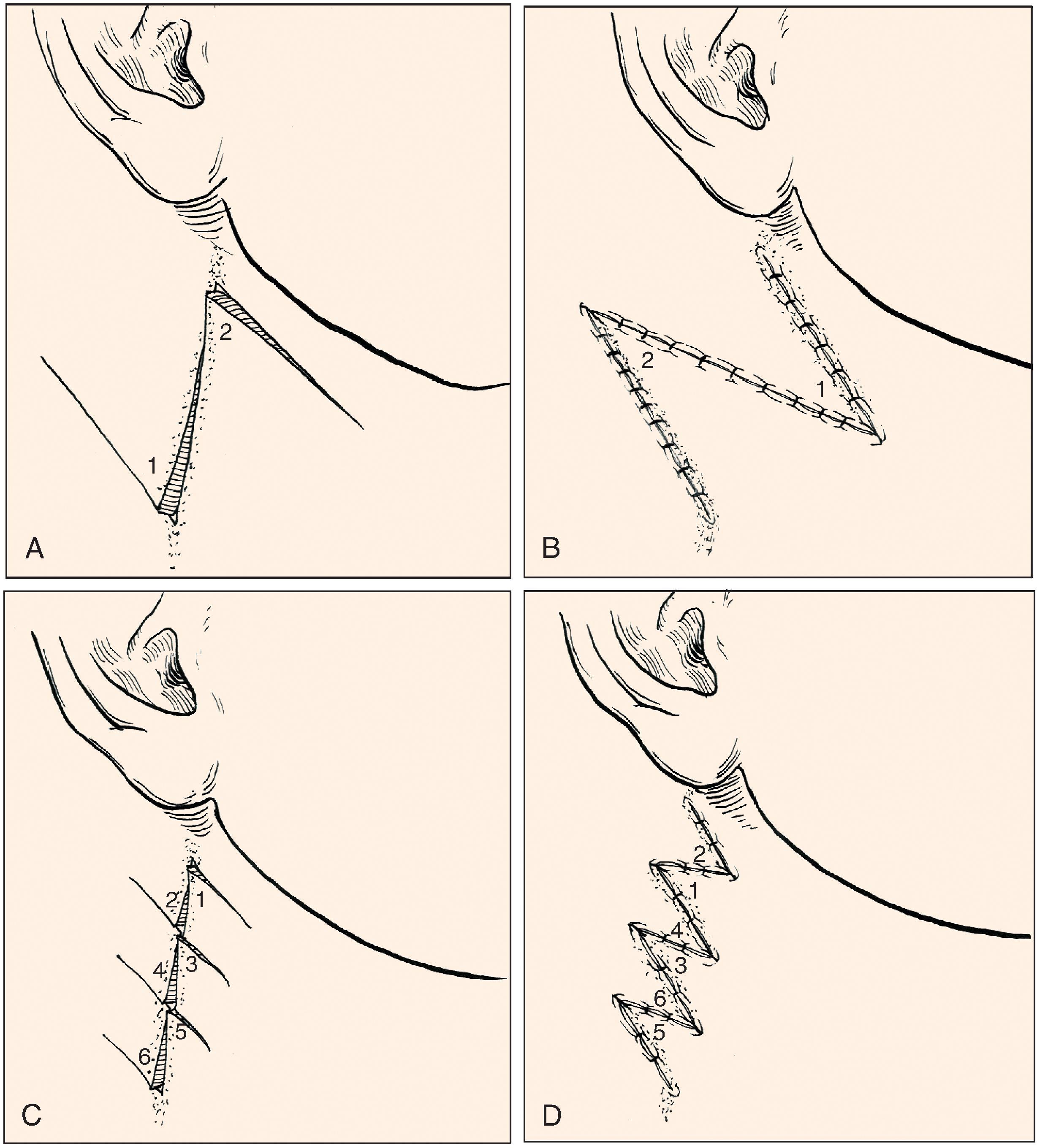
Multiple Z-plasties may be of value in treating forehead scars by repositioning portions of the scar into horizontal forehead furrows ( Fig. 14.15 ). Although the four-flap Z-plasty has few indications in the head and neck, it is occasionally useful for correction of lower eyelid ectropion or retraction (see Fig. 14.15 ). Multiple Z-plasties are also useful for improving the contour of curvilinear flaps that have trap-door deformities, such as might occur with a cheek transposition flap ( Fig. 14.16 ). These deformities essentially result from scar contracture. Thus an effective method of correcting trap-door deformity is scar lengthening achieved with Z-plasty and simultaneous contouring of the flap.
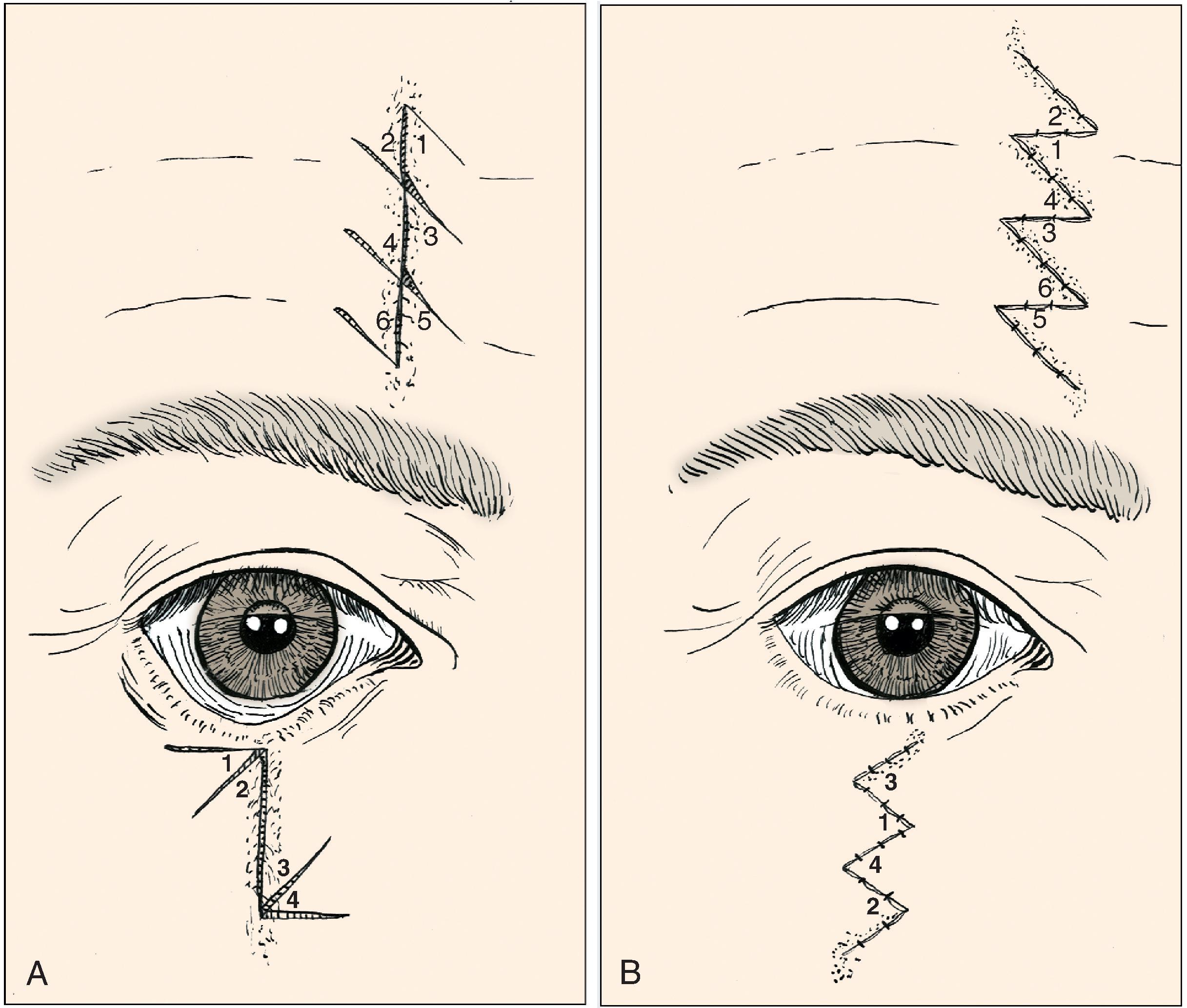
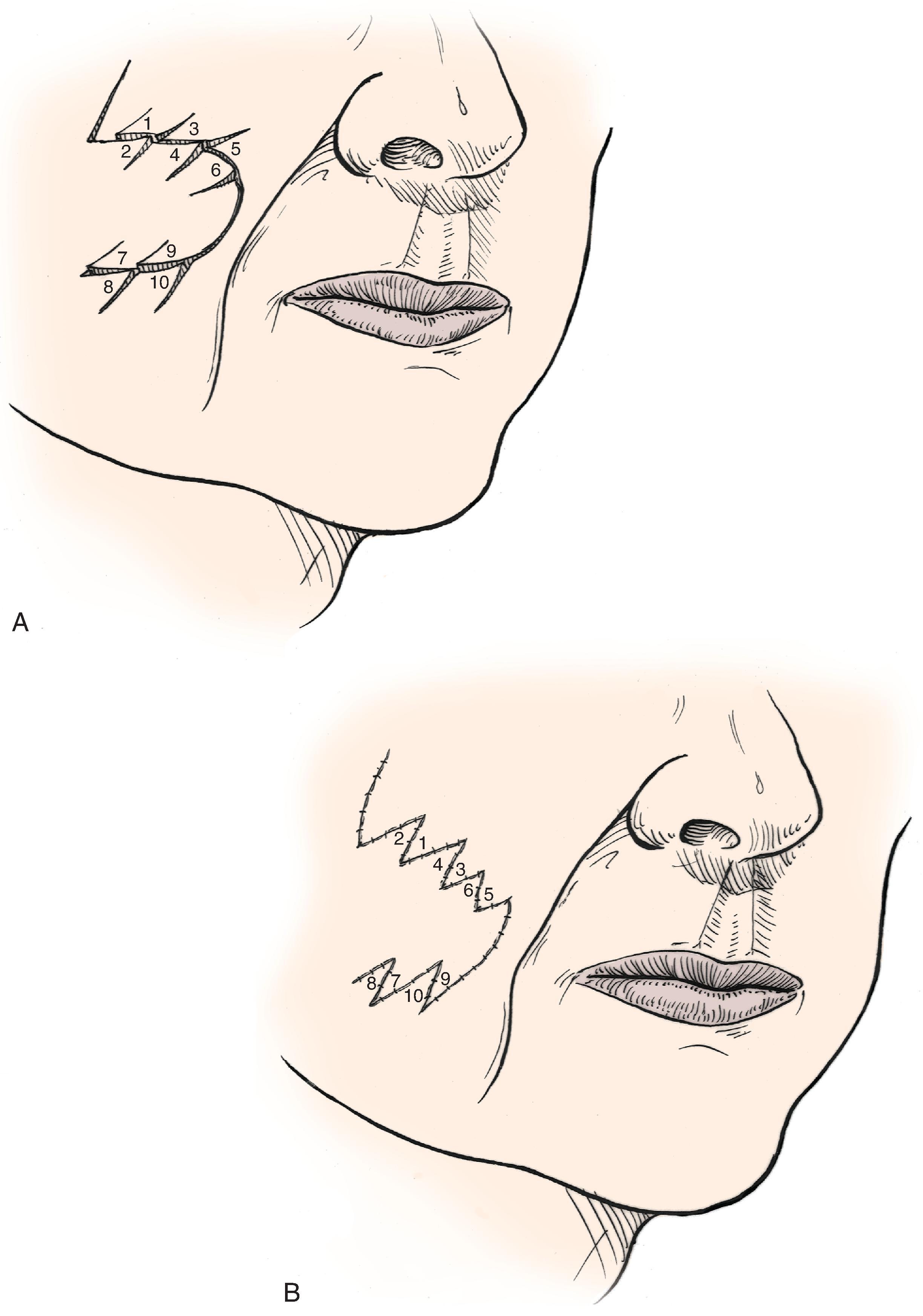
Z-plasties may be designed with unequal angles. The more acutely angulated flap is transposed in a greater arc than the larger angled flap. Variations on such unequal Z-plasties can be used to treat asymmetric facial features. An example is when a scar contracture distorts the oral commissure ( Fig. 14.17 ). In such cases, the larger flap consisting of the commissure is undermined only to a limited degree and the smaller flap is transposed into the tissue void created by release of the contracted commissure. This facilitates transfer of the oral commissure to a more natural position.
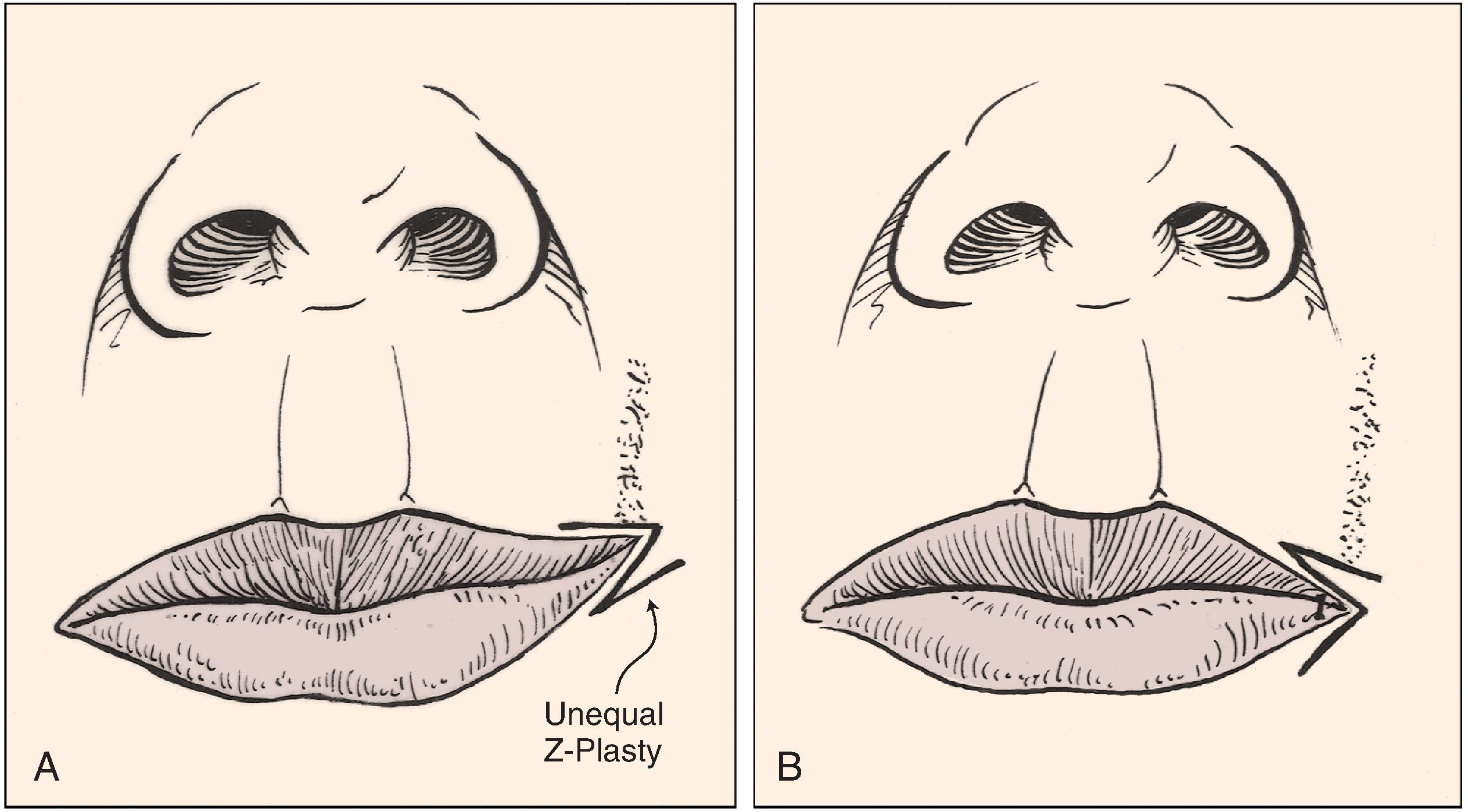
Z-plasty is one of the oldest concepts in plastic surgery and remains a prevalent and important technique. An understanding of its geometric principles is critical to its successful application. Z-plasty is a double transposition flap technique that is used to lengthen contracted scars, to change the orientation of scars for better alignment with RSTLs, or to interrupt straight scars for better camouflage. Z-plasty is also helpful in the repair of some cutaneous defects and for realignment of malpositioned facial structures. Classic indications for Z-plasty include realignment of scars that are not parallel to RSTLs, correction of scars that cause contracted webbing of the neck, repositioning of an oral commissure or eyelid that is malpositioned from scarring, and correction of congenital or post-traumatic epicanthal folds. Z-plasty techniques can also be used for the repair of cleft or torn ear lobes , and primary or secondary repair of a cleft palate. , It is impossible to list all of the reported uses of Z-plasty described in the literature. Suffice it to say that with a thorough understanding of its principles, Z-plasty is an extremely powerful tool in the reconstructive surgeon’s armamentarium.
Become a Clinical Tree membership for Full access and enjoy Unlimited articles
If you are a member. Log in here